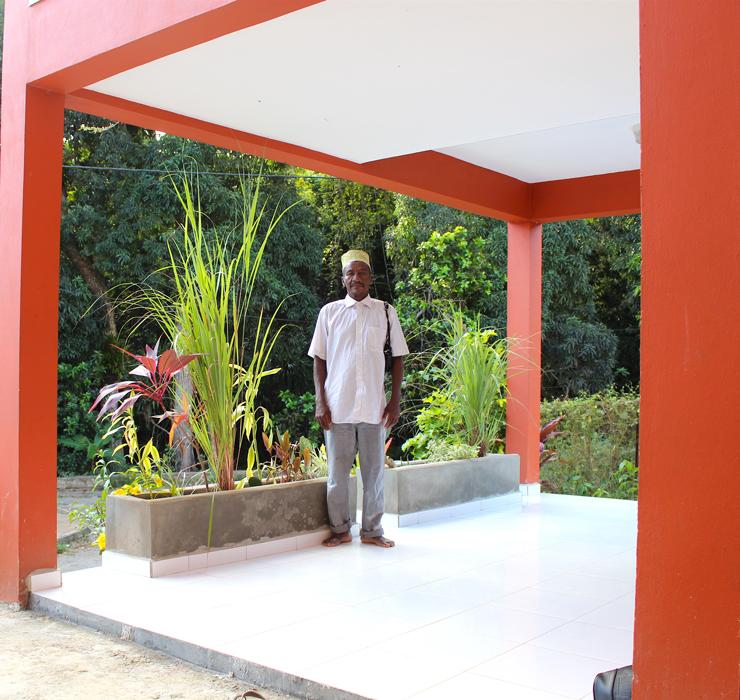Mayotte: Modern housing respecting traditions


In Southern Mayotte, at the end of a winding road and a stone’s throw from the sea, the first social homeownership apartment building has been built in the territory of Mangua Bé. This pioneering high-rise building in the 101st French Department, where residents in Mayotte are used to being owners of detached ground floor houses, is home to low-income families or elderly and unemployed people who have benefited from loans to buy an apartment thanks to an AFD guarantee.
This project has been designed by the Municipality of Chirongui which, with AFD’s support, has developed plots of land. It is located in Poroani village and has required considerable mediation with the population to ensure that it takes ownership of these spaces which are different from their usual way of life.
But the residents of Mangua Bé, who mainly used to live in completely unregulated corrugated iron huts with no modern equipment, have very quickly taken ownership of the space. The residence combines modernity and tradition. People live as a community, with their doors and windows open. Families help each other, go from home to home, chat inside where it is cool, or share a mat by the pathway so that they can watch over the children playing.


In May 2018, in response to a major social movement which paralyzed the island for several months, the Minister for Overseas France presented a EUR 1.3bn catch-up plan called “The State’s Action for your Daily Lives”, comprising 53 measures, including 5 for housing. The first of these measures establishes the creation of an Operation of National Interest (OIN) “in order to accelerate housing production and organize the structuring of business areas in an optimal manner”, with increased means for the Public Land and Development Establishment. The second commitment increases the number of social housing units to be built in 2018 to 400. This objective is supported by a 50% increase in housing policy loans.
The third measure: support for two municipalities and an inter-municipality in the context of projects to revitalize their city centers. The fourth measure concerns financial support from the National Urban Renewal Agency (ANRU) for operations to modernize neighborhoods in the administrative capitals of Dzaoudzi, Nord and Petite-Terre. Finally, the fifth point provides for greater policing powers for the Prefect in order to fight against illegal and substandard housing.

“Housing in Mayotte is marked by precariousness”, warns INSEE in the preamble to its study on housing in Mayotte, based on the latest available data from 2013. Indeed, the results of the institute’s major survey show that the housing conditions of residents in France’s 101st Department “are very far from national standards”.
In 2013, 37% of the some 50,000 main residences in Mayotte were detached corrugated huts. Another dramatic figure: “Over six homes in ten have no basic sanitary comfort, meaning that they do not have at least one of the three following elements: water, bath or shower, toilet”. Furthermore, 28% of households did not have running water in their homes.
This situation is comparable to Réunion thirty years ago, or French Guiana twenty years ago, notes INSEE, which does, however, moderate the situation: “There has been significant progress in ten years: in 2002, 75% of households did not have running water”. In contrast, there is widespread access to electricity, with 94% of households – legally or illegally – connected. However, in 55% of cases, “the electrical installation is potentially dangerous”. Another characteristic of housing in Mayotte: the overcrowded houses. In 63% of cases, “there is a room lacking compared to the composition of the household”, notes INSEE.
For all these reasons, a third of households in Mayotte state that they are “dissatisfied” with their living conditions, considering them to be “insufficient” or “highly insufficient”. This proportion is three times higher than in Réunion and five times higher than in the provinces. These figures give legitimacy to the action of the State, local authorities and their partners for housing in Mayotte.

The new Public Land and Development Establishment of Mayotte (EPFAM) was set up in June 2017. Its aim is to conduct operations to promote land development, urban renewal and economic and agricultural development on the island. Among its partners (local authorities, public and private decision-makers), EPFAM can rely on support from AFD, which is assisting it in the definition of its land acquisition strategy.